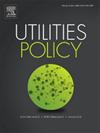Electricity prices, renewable energy, and sustainability of the energy and manufacturing sectors in the new EU member states
IF 4.4
3区 经济学
Q3 ENERGY & FUELS
引用次数: 0
Abstract
This paper investigates the impact of renewable energy consumption, foreign direct investment (FDI), and electricity pricing on carbon dioxide (CO2) emissions in the energy supply and manufacturing sectors of Central and Eastern European (CEE) countries in the period 2007–2021. This study uses dynamic panel data models to examine the Environmental Kuznets Curve (EKC) and the pollution haven and halo hypotheses to understand the sector-specific emission patterns and identify the factors that influence environmental sustainability. Most other studies do not consider a sectoral approach providing the same proposals for all sectors, while this paper provides original, sector-targeted policy recommendations to balance economic growth with EU climate goals, emphasizing renewable energy incentives and stringent FDI standards. The results reveal an N-shaped relationship between economic growth and CO2 emissions in the energy sector and an inverted N-shaped relationship in the manufacturing sector, indicating distinct emission trajectories that warrant targeted policy responses. The empirical findings demonstrate that renewable energy consumption significantly reduces emissions in both sectors, substantially impacting the energy sector. Additionally, the U-shaped relationship between FDI and CO2 emissions suggests that while FDI initially brings cleaner technologies (halo effect), it may later contribute to higher emissions under insufficient environmental regulations (haven effect). Higher electricity prices for non-household consumers are also found to effectively lower emissions, particularly in the energy sector, by encouraging energy-efficient practices.
欧盟新成员国的电价、可再生能源以及能源和制造业的可持续性
本文研究了2007-2021年期间中欧和东欧国家可再生能源消费、外国直接投资(FDI)和电价对能源供应和制造业二氧化碳排放的影响。本研究采用动态面板数据模型检验环境库兹涅茨曲线(EKC)和污染港假说和污染晕假说,以了解行业特定排放模式,并确定影响环境可持续性的因素。大多数其他研究没有考虑为所有部门提供相同建议的部门方法,而本文提供了原始的、针对部门的政策建议,以平衡经济增长与欧盟气候目标,强调可再生能源激励和严格的外国直接投资标准。研究结果表明,能源行业的经济增长与二氧化碳排放呈n型关系,制造业的经济增长与二氧化碳排放呈倒n型关系,表明了不同的排放轨迹,需要有针对性的政策应对。实证结果表明,可再生能源消费显著减少了两个部门的排放,对能源部门产生了实质性影响。此外,FDI与二氧化碳排放之间的u型关系表明,虽然FDI最初带来了更清洁的技术(光环效应),但在环境法规不足的情况下,FDI可能会导致更高的排放(避风港效应)。研究还发现,提高非家庭消费者的电价,通过鼓励节能做法,可以有效地降低排放,特别是在能源部门。
本文章由计算机程序翻译,如有差异,请以英文原文为准。
求助全文
约1分钟内获得全文
求助全文
来源期刊

Utilities Policy
ENERGY & FUELS-ENVIRONMENTAL SCIENCES
CiteScore
6.80
自引率
10.00%
发文量
94
审稿时长
66 days
期刊介绍:
Utilities Policy is deliberately international, interdisciplinary, and intersectoral. Articles address utility trends and issues in both developed and developing economies. Authors and reviewers come from various disciplines, including economics, political science, sociology, law, finance, accounting, management, and engineering. Areas of focus include the utility and network industries providing essential electricity, natural gas, water and wastewater, solid waste, communications, broadband, postal, and public transportation services.
Utilities Policy invites submissions that apply various quantitative and qualitative methods. Contributions are welcome from both established and emerging scholars as well as accomplished practitioners. Interdisciplinary, comparative, and applied works are encouraged. Submissions to the journal should have a clear focus on governance, performance, and/or analysis of public utilities with an aim toward informing the policymaking process and providing recommendations as appropriate. Relevant topics and issues include but are not limited to industry structures and ownership, market design and dynamics, economic development, resource planning, system modeling, accounting and finance, infrastructure investment, supply and demand efficiency, strategic management and productivity, network operations and integration, supply chains, adaptation and flexibility, service-quality standards, benchmarking and metrics, benefit-cost analysis, behavior and incentives, pricing and demand response, economic and environmental regulation, regulatory performance and impact, restructuring and deregulation, and policy institutions.
 求助内容:
求助内容: 应助结果提醒方式:
应助结果提醒方式:


